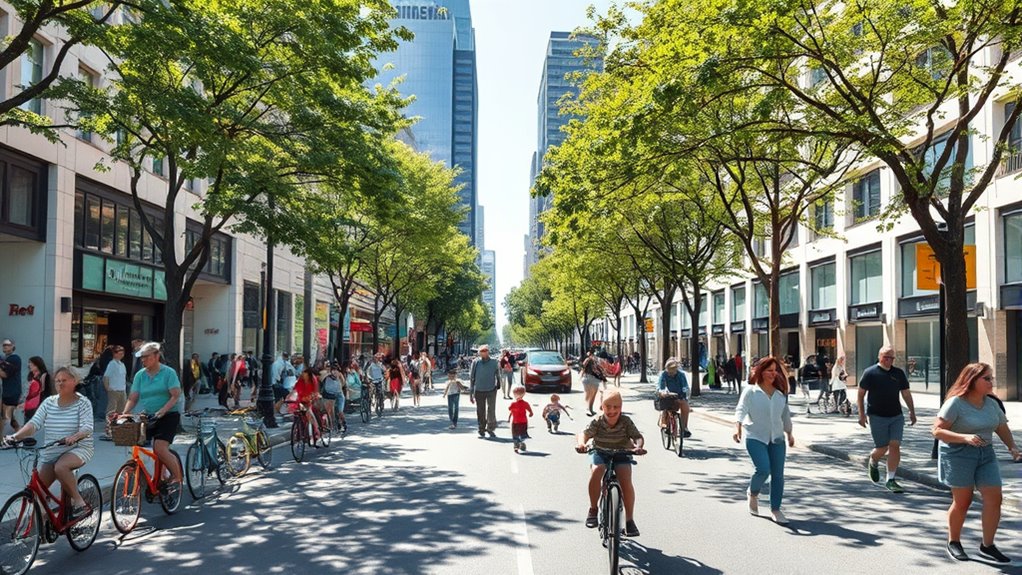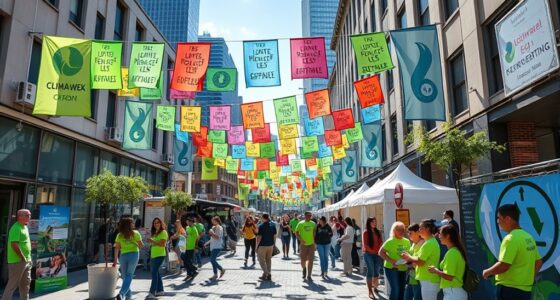Car-Free Days are leading an urban movement that’s taking cities worldwide by storm, helping you experience cleaner air, less traffic, and quieter streets. By temporarily banning cars, cities boost public transit, encourage outdoor activities, and showcase the benefits of sustainable urban living. You’ll see how communities come together to enjoy public spaces and learn about smarter transportation options. Keep exploring to discover how this movement might transform the way your city moves and breathes.
Key Takeaways
- Car-Free Days aim to reduce pollution, ease traffic, and promote healthier urban lifestyles worldwide.
- They temporarily close city streets to vehicles, highlighting environmental and social benefits of reduced car use.
- Public transportation often expands during these events, encouraging residents to switch to sustainable transit options.
- Community activities and educational programs foster awareness about urban planning and sustainable mobility.
- Car-Free Days demonstrate the positive impact of collective action, inspiring long-term shifts toward greener cities globally.

Many cities around the world are embracing Car-Free Days as a way to reduce pollution, ease traffic congestion, and encourage healthier lifestyles. On these designated days, you’ll find streets closed off to cars, creating a rare opportunity to explore urban spaces without the usual noise and fumes. Instead of the usual traffic jams, you can walk, cycle, or use public transportation to get around. This shift not only makes the city more accessible but also highlights how much cleaner and quieter the environment can become when vehicles are temporarily removed from the roads.
Cities worldwide host Car-Free Days to reduce pollution and promote healthier, quieter urban environments.
Public transportation plays an essential role during Car-Free Days. Many cities ramp up their bus, metro, and tram services to accommodate the surge of people enthusiastic to participate. As a result, you might notice increased frequency and improved reliability, making it easier to leave your car at home. Using public transit during these days not only demonstrates its importance as an alternative to driving but also considerably impacts air quality. Without the emissions from countless individual vehicles, the air becomes noticeably fresher and healthier for everyone. You may even feel a difference in your own breathing, especially if you typically spend time in traffic-heavy areas. Additionally, participating in Car-Free Days can strengthen your understanding of urban planning and how sustainable transportation plays a vital role in creating healthier cities.
Participating in Car-Free Days helps you see the tangible benefits of reducing your reliance on personal cars. When streets are free of engines, you’ll likely enjoy clearer views of the city’s architecture and environment. Parks and public spaces often become more lively and inviting, encouraging you to spend more time outdoors. This experience can inspire you to rethink your daily commute and consider more sustainable options like biking or walking. The noticeable improvement in air quality during these events reminds you of the positive impact that collective action can have on urban health.
Moreover, these days foster a sense of community. You might join a group walk or bike ride, connecting with neighbors and fellow residents who share your interest in a cleaner, healthier city. Local authorities often organize events and activities to promote sustainable transportation, making the day both enjoyable and educational. As you witness fewer cars on the road, it becomes clear that Car-Free Days aren’t just about temporary relief; they’re a powerful statement about the future of urban living.
In essence, Car-Free Days serve as a practical reminder that reducing car dependence benefits everyone. By utilizing public transportation and embracing alternative modes of travel, you contribute directly to improving air quality and creating a more livable city. These days show that, with a bit of effort, your city can breathe easier, become more vibrant, and move toward a healthier, more sustainable future.
Frequently Asked Questions
How Do Cities Measure the Success of Car-Free Days?
To measure the success of car-free days, you look at air quality metrics to see improvements in pollution levels and pedestrian counts to assess how many people enjoy the reduced traffic. You also gather data on public feedback and traffic flow changes. If air quality improves and more pedestrians are out, you can confidently say the event’s successful in promoting healthier, more walkable urban spaces.
What Are the Economic Impacts of Car-Free Days on Local Businesses?
Imagine bustling streets alive with shoppers and outdoor cafes, thanks to car-free days. You see local business revenue often rise as consumer spending patterns shift toward in-person experiences and community events. While some businesses may face temporary challenges, many thrive through increased foot traffic and sales. Overall, these days can boost local economies by encouraging residents and visitors to explore and support small businesses in a vibrant, car-free environment.
How Do Residents With Mobility Challenges Participate in Car-Free Days?
You can participate in car-free days through accessible participation options designed for mobility challenges. Adaptive infrastructure, like ramps and designated safe zones, guarantees you can navigate and enjoy events comfortably. City planners often provide specialized transportation or mobility aids, making it easier for you to join outdoor activities and community gatherings. This inclusive approach helps everyone, regardless of mobility, experience the benefits of cleaner air and vibrant urban spaces.
Are There Any Environmental Drawbacks to Implementing Car-Free Days?
You might wonder if there are environmental drawbacks to car-free days. While they generally improve air quality and reduce noise pollution, challenges can arise. For example, increased congestion on alternative routes may cause localized pollution, and temporary rerouting can strain existing infrastructure. Nonetheless, these drawbacks are often minor compared to the benefits, making car-free days a valuable way to promote cleaner urban environments and healthier communities.
How Can Communities Sustain Car-Free Day Initiatives Long-Term?
Think of sustaining a car-free day as tending a delicate garden; it requires constant nurturing. You can do this by fostering community engagement through events and education, making participation a shared goal. Securing policy support guarantees long-term commitment, like planting sturdy trees for shade. Together, these strategies create a resilient movement that transforms fleeting days into lasting change, inspiring your community to embrace sustainable habits with passion and perseverance.
Conclusion
Think of Car-Free Days as a invigorating gust of fresh air in a bustling city jungle. Just like clearing out overgrown weeds makes space for new growth, these days give your city room to breathe and thrive. By choosing to leave your car behind, you become a gardener of change, helping your urban landscape blossom into a cleaner, calmer place. Embrace this movement, and watch your city transform, one car-free day at a time.










